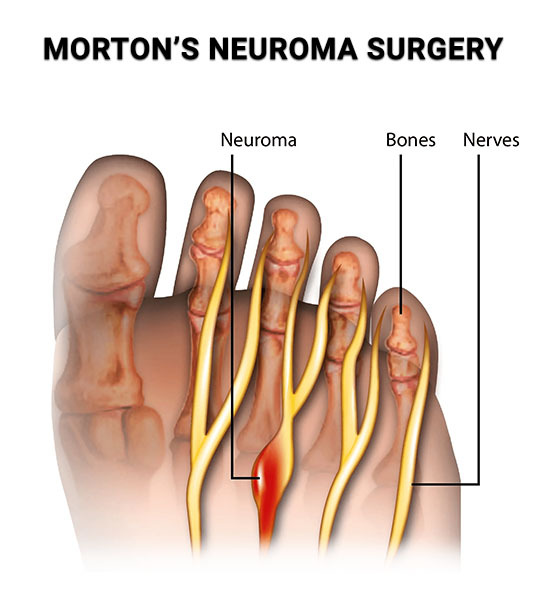Share Post
Complications of Morton’s Neuroma if left untreated
Morton’s neuroma is a thickening of the tissue surrounding an irritated or damaged nerve in your foot. Treatments that you can try on your own can often alleviate the symptoms. Morton’s neuroma, also known as intermetatarsal neuroma, is a toe thickening. This tissue is located near a nerve. Pressure on the nerve causes irritation and pain.

The main symptom of Morton’s neuroma is pain, which is often intermittent. It may feel like you’re standing on a marble or pebble in your shoe or a bunched-up sock, or it may feel like a burning pain in the ball of your foot.
As the pain spreads, your toes may become numb or tingly. A Morton’s neuroma causes your nerve to become painfully inflamed and enlarged. The pain is frequently worse at night because wearing shoes all day (especially wring ones) puts pressure on the tender nerve area. Because of the constant pain and pressure, some people with Morton’s neuroma develop an abnormal walking pattern known as an “abnormal gait”. This can lead to other issues like arthritis and back pain.

They can cause permanent nerve damage if left untreated. Morton’s neuromas develop in the ball of the foot, most commonly between the second and third toes or the third and fourth toes. They develop along the nerves that supply sensation to the toes. It will not go away on its own and will most likely worsen.
It can eventually progress to severe pain that lasts for days or even weeks. This can become permanent in some cases, and some people live with Morton’s neuroma for years, which is a shame because it is treatable. The most common surgery for Morton’s neuroma is a neurectomy. A portion of the nerve tissue is removed by the surgeon. Morton’s neuroma can be successfully treated surgically.
To protect your foot and ankle after surgery, you will be fitted with a cast or boot. Rest and physical therapy will be required to fully recover. Physical therapists create customized recovery plans based on the severity of your condition. Although primary excision relieves symptoms in 50% to 85% of patients, there is a chance that Morton’s neuroma will reappear even after successful surgery. Several common symptoms may reappear after surgery due to a misdiagnosis, insufficient resection, or pressure adhesion on a nerve stump neuroma.
Furthermore, if the problem is not treated, a neuroma can spread to nerves in the ankle or leg. Numbness and loss of sensation. Advanced nerve compression can cause you to lose feeling in your toes and the ball of your foot. If you’re experiencing pain and discomfort from Morton’s Neuroma, consider speaking to our top-rated Podiatrist or Visit Feldman & Leavitt Foot and Ankle Specialists about the best treatment plan for your needs.
As a general rule, surgical bunion procedures are performed on an outpatient basis in an Alberta Health Services (AHS) approve Surgical Center or in a Hospital. Surgical procedural costs are covered by AHS or the patient may opt for private surgery to avoid a waiting time.

